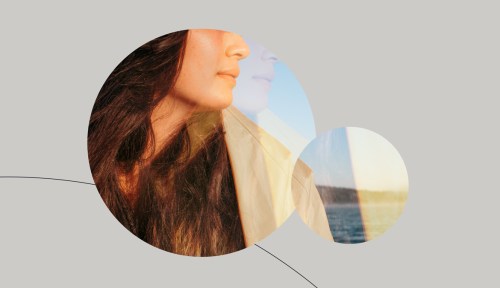Every person—regardless of race, socioeconomic background, and gender—can experience trauma. Although trauma doesn’t discriminate, it does affect different cultural communities in different ways.
Experts in This Article
Jessica Barudin is Kwakwaka’wakw from the ‘Namgis First Nation in Alert Bay, BC. She Indigenous health researcher, yoga teacher and doula. She has spent the last 10 years working professionally in Indigenous peoples’ health and education including a variety of roles in health research, health promotion, project management, and community engagement.
Jillene Joseph is a member of the People of the White Clay tribal community in Montana and the executive director at the Native Wellness Institute, a non-profit aiming to improve the health and well-being of Native people.
Kathy Farah, MD, is a family practice physician who practices integrative and mind-body medicine. Dr. Farah also has a consultation practice at the Pain Palliative Care and Integrative Medicine Clinic at Children’s Hospitals and Clinic in Minneapolis.
Jillene Joseph is a member of the People of the White Clay tribal community in Montana and the executive director at the Native Wellness Institute, a non-profit aiming to improve the health and well-being of Native people. She explains that for Native people, trauma is historic and passed down through generations. This deep-rooted trauma, she says, has contributed to a number of obstacles in Native communities, including high rates of suicide, alcoholism, and depression.
But there are several organizations and trauma workers that are transforming Native communities through healing work. And the effects of this healing work have the power to be passed down intergenerationally, too.
What does historic trauma look like?
Scientific studies show that trauma chemically changes someone’s genes, and those changes can be passed down through generations. (This field of science is called epigenetics.) One scientific paper focusing on the role of epigenetics in health disparities among Native Americans says that inherited trauma changes the genes directly involved in regulating the body’s stress response. Separate research has found that post-traumatic stress syndrome, for example, is at least partially caused by genetic predispositions.
Scientific studies show that trauma chemically changes someone’s genes, and those changes can be passed down through generations.
Joseph says alcoholism is another example of how inherited trauma can manifest physically. “White people used to intentionally give alcohol to tribal people, particularly men, to subdue them,” she says. “It was given as chemical warfare.” She explains that both men and women in Native communities began to be used as a coping mechanism. “When pregnant women drink alcohol, it can affect the brain of the fetus. This is where neurotrauma can come in,” Joseph says. “Alcoholism is, of course, a worldwide issue, but our relationship with alcohol is historic and it has [quite literally] birthed an alcoholic movement.”
The emotions behind trauma can be inherited, too. Joseph says one example of this is the intentional spread of smallpox and other infectious diseases by Europeans migrating to the West. “During the pandemic, a lot of Native people were triggered because of that,” she says. “An elder friend of mine told me that every day, she drives by the cemetery where her ancestors who died of smallpox are buried. She realized at the beginning of the pandemic that she was still holding on to the hurt and anger from that, which the pandemic triggered for her.” The hurt and anger felt by Joseph’s friend is not an anomaly. In one survey of 306 Native Americans, over half reported thinking about historic losses occasionally, which caused them distress.
Joseph says many Native people are carrying this inherited trauma or living with its effects without realizing its root cause. “As trauma healers, we help people connect the dots between trauma and the lasting behaviors,” she says. “This is super important because you can’t heal if you don’t know where your trauma is coming from.”
What healing from historic trauma looks like
Joseph works with the Native Wellness Institute, where healing trauma focuses on four pillars: physical, mental, emotional, and spiritual. As Joseph mentioned, helping people identify where the source of their trauma stems from and how it is showing up in their lives is the first step toward healing. From there, she says, workshops focus on how to feel whole through the four pillars and learning how they are all connected.
“For example, we talk about how the way we’re feeling physically is connected to how we feel mentally and emotionally,” she says. The mind-body connection has been well-established by science; what you eat truly does affect your mood. This is true for everyone, but in the healing workshops specifically for Indigenous people, the focus is on traditional herbs, foods, and cooking methods that are essential parts of their culture.
Similarly, she says, spending time in nature is the primary way of making the connection between physical activity and mental health. Joseph points out that many of the ways scientists are showing to be effective for healing from trauma are based on ways of life that are traditional to Indigenous people; spending time in nature is one example of this. “Similarly, meditation, prayer, and drum circles are all traditional practices to Native people that Western researchers are now showing to be healing,” she says. Explaining how these practices not only help with healing from trauma but are also part of one’s heritage is powerful, Joseph says.
Indigenous health scholar and yoga instructor Jessica Barudin, who is Kwakwa̱ka̱ʼwakw from the ‘Namgis First Nation in Alert Bay, BC, is centering her healing work through yoga with the First Nations Women’s Yoga Initiative, partnership with Yoga Outreach Society and Kwakwaka’wakw communities. “Yoga has really been there for me in my own journey of working through grief, including the loss of my mother and father,” she says. Currently in the process of pursuing her doctorate, Barudin’s focus is creating a culturally-responsive, trauma-infored yoga program specifically for Indigenous women, youth and LGBTQ+ people. “As much as possible, we are honoring the [Eastern] roots of yoga. My intention is really to uphold the integrity of yoga as it stands as a beautiful science and way of life,” she says.
Sometimes, she says, she’ll also incorporate practices that honor Indigenous roots and cultural practices. “If it’s appropriate, I’ll have smudging to open the yoga practice. Or, I’ll start in a circle and we all pass an eagle feather so people have the space to connect and share their voice and prayers,” Barudin says. She explains that trauma is held in the body; this is certainly true of historical trauma. What she is creating is a safe space for Indigenous people to work through that using yoga and connection to community.
Using cultural compassion to help Indigenous communities heal
There are also ways that Western trauma healers are working with Native communities. One example is The Center for Mind-Body Medicine, which was founded by Harvard-trained psychiatrist and former National Institute of Mental Health researcher James Gordon, MD. Joseph and Barudin say that non-Native people can certainly play a role in working with tribal communities, but it requires cultural compassion, which means considering the similarities and differences of how a Native person’s experience may compare to a non-Native person’s.
One of the Center’s trauma workers, Kathy Farah, MD, has been working with the Pine Ridge Reservation for more than 10 years. Dr. Farah says tribal leaders initially extended an invite to the Center to come and work with them. This, she says, is crucial for non-Native trauma healers to keep in mind: It’s important to be invited to work together, rather than forcing yourself in and imposing Western ideologies. “With any community we work with, we always ask, ‘What do you need?’ and ‘Who would be interested in listening to what we have to offer?'” Dr. Farah says. In this case, tribal leaders voiced a need for suicide prevention, so much of the healing work Dr. Farah and other trauma healers from the Center have done the past decade has focused on that.
Similarly to Joseph, Dr. Farah says the first step in their healing work is helping people understand the source of their trauma and the science behind how it manifests. She says that many people—of any cultural background—do not know the science behind how trauma affects them, but understanding the connection is powerful. “For example, someone may think, ‘Why did I stay in that abusive relationship? Why didn’t I leave?’ They don’t know the body’s freeze response actually shuts the body down. Knowing this normalizes what someone may be feeling shameful about,” she says.
Then, she says, Center workers also teach science-based practices, such as deep belly breathing, that can be used to heal. She emphasizes that science teaching such as this isn’t meant to replace tribal healing traditions; in fact, learning them helps people see a connection between the two concepts. “We’ll talk about the connection between movement and mental health and someone will say, ‘Oh yeah, this is like going to a pow-wow or to Sun Dance.’ It’s a two-way conversation that’s mutually respectful. We’re teaching each other,” Dr. Farah says.
“Healing can have the same momentum, impact, and effect as trauma. Just like trauma can be intergenerational, so can healing.” — Jessica Barudin
Like trauma, healing can be passed on as well
Joseph, Barudin, and Dr. Farah all say their healing work has looked a bit different during the pandemic. While they miss the intimacy of in-person workshops, they all say they’ve been pleasantly surprised at how well everything has adapted for video meetings. “We try to make it as interactive as possible,” Joseph says. “Sometimes we’ll give people the instructions for a specific activity and tell them to go outside for 15 minutes to do it. Then, we’ll all get back together on Zoom and share what the experience was like with each other. We’ve still found ways to connect.”
Barudin says teaching some of her yoga classes over Zoom has actually helped expand them to people who otherwise would not have been able to join. “It’s not as easy to connect with people virtually as it is in-person, but it is possible, and I’m excited about the growing interest there seems to be across Turtle Island,” she says.
What Barudin says she most wants people to know is that intergenerational trauma can be healed and released from the body through embodied practices like yoga and connection to ceremony and culture. “I find that sometimes the narrative gets really fixated on powerlessness or creating a victim when people have endured or experienced trauma. But there is a lot of resilience and beautiful stories of strength and healing that comes with those lived experiences,” Barudin says. “Healing can have the same momentum, impact, and effect as trauma. Just like trauma can be intergenerational, so can healing.”
To her, the crux of healing work in Indigenous communities lies here, in awakening that revelation and bringing forth an emotion that can overtake the grief of trauma: peace.
Oh hi! You look like someone who loves free workouts, discounts for cult-fave wellness brands, and exclusive Well+Good content. Sign up for Well+, our online community of wellness insiders, and unlock your rewards instantly.
Sign Up for Our Daily Newsletter
Get all the latest in wellness, trends, food, fitness, beauty, and more delivered right to your inbox.
Got it, you've been added to our email list.











